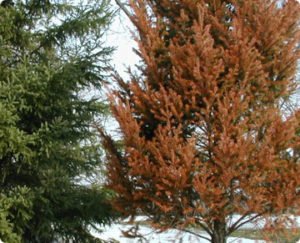7 Signs of Winter Injury and What You Can Do About It
Now that we are more than halfway through with the winter–and hopefully the worst of it behind us–we can start looking forward to the thawing out process. However, as we slowly move closer towards spring, you may notice the browning on your trees and shrubs and in some cases the death. The most common culprit this time of the year is winter injury.
What is winter injury you ask? It is the damage to or death of foliage, roots, or limbs on trees and shrubs due to extreme fluctuations in temperature, damage from salt spray or damage from snow and ice. The frequency and severity of winter injury are dependent on plant species, location, site conditions, the health of the plant, and the winter conditions.

What are the signs of winter injury?

- Brown foliage on conifers as a result of excessive water loss. This shows up right away in late winter or early spring.
- Brown foliage on conifers on the upper half beginning from where the snow line ends. The lower half below the snow line will remain green and healthy.
- Sunscald, which appears as an elongated canker on thin-barked trees, including maple, willow, white pine, and linden.
- Frost cracks on trunks and limbs especially on south or southwest facing portions of deciduous trees.
- Root damage, which will lead to wilting or decline in growth in the spring.
- Breakage due to heavy snow or ice.
- Death of a portion or entire plant.
What can I do to avoid tree or shrub winter injury?
- South and southwest facing trees and shrubs often suffer from repeated freezing and thawing and harsh drying winds. It is critical that you choose the right tree for the right location and zone is the best way to prevent most issues you will encounter with your trees or shrubs.
- Deciduous trees that are prone to winter injury are young: lindens, maples, apple species, cherry species, honeylocust, plum, and mountain ash. Conifers that are prone to winter injury are yew, hemlock, and arborvitae.
- Avoid planting trees in microclimates that will increase the likelihood of winter injury such as next heated air vents.
- Proper care which includes watering, fertilizing and especially with mulching beginning from when the ground thaws in the spring up until the ground freezes in the fall.
- Keeping your trees and shrubs regularly pruned to reduce the damage from snow and ice.
- Avoid planting susceptible or salt intolerant species next to highly salted roads and walkways. Or if you already have an established salt sensitive tree or shrub, try reducing the amount of salt used in the area.
- Thoroughly irrigate the salt out the soil around trees near roadways when the ground has thawed.
- Lastly, prune out the affected branches after bud break as this can assist you in determining where the damage has occurred and where the tree or shrub is still healthy and alive.

Can my tree or shrub recover from winter injury?
For help diagnosing and treating winter injury, consult with one of our arborists!
Other items you may be interested in:

Five Reasons To Prune Your Trees This Winter
Pruning is a key part of keeping trees healthy and safe to live with in your Minnesota yard. It’s also one of the only landscape

Abiotic Tree Disorders
Preventing & Controlling Abiotic Tree Disorders in Minnesota There are two types of tree disorders. Disorders caused by living things such as insects, bacteria, fungi,

Consulting & Diagnosis
Tree Health Assessment, Consulting, & Diagnosis in Minnesota Are you worried about the health of a tree or shrub in your landscape? Getting it assessed



